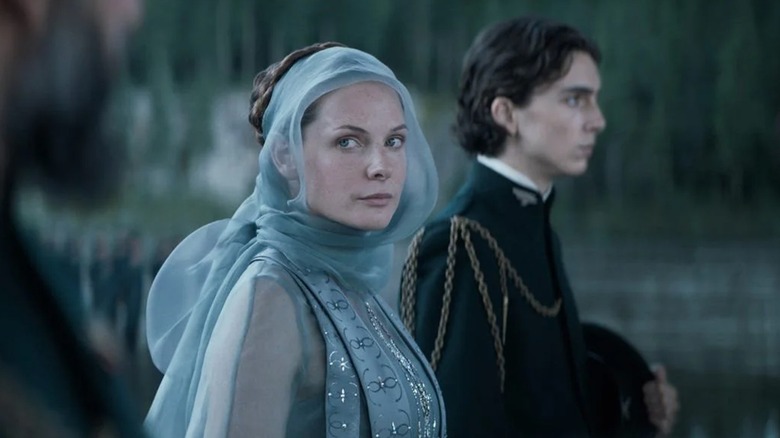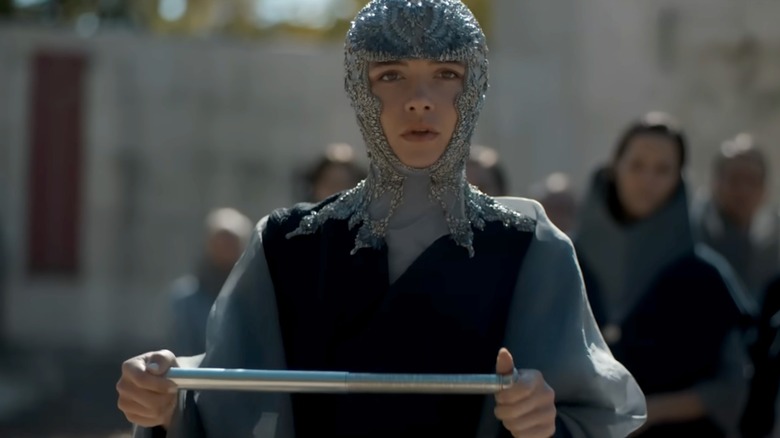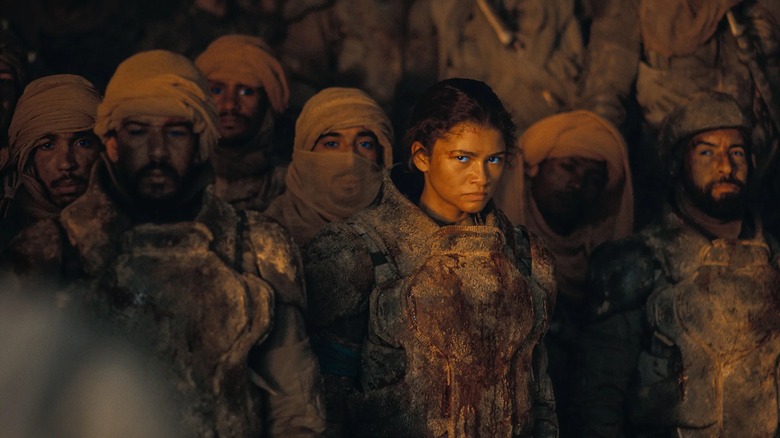
This post contains spoilers for Frank Herbert’s “Dune” novel series.
The lush greenery and oceanic beauty of Caladan emerge as our entry point into the rich, expansive world of “Dune,” with Paul Atreides’ home planet acting as a frame of reference for the worlds to come. Denis Villeneuve’s “Dune” saga depicts this environmental bounty in vivid hues, the beautiful planet being synonymous with the Atreides regime and the flourishing economy that accompanies it. The Atreides legacy is an enduring one, spanning more than 10,000 years until Duke Leto Atreides I is asked to relinquish fiefdom over the planet and make his way to Arrakis in 10191 A.G. (After Guild). This takeover of the desert planet from House Harkonnen alters the trajectory of the Atreides legacy, leaving Caladan’s fate up in the air.
As Frank Herbert’s “Dune” novel progresses (intricately exploring Paul’s relationship with the Fremen on Arrakis), the focus completely shifts away from Caladan for good reason. The oceanic planet is meant to represent the cocoon of security Paul needs to shed to embrace his newfound duty as an Atreides, while his core identity undergoes radical change during his time with the Fremen. The complex threads of warped visions and prophecies set Paul and the Fremen on a path of no return, wherein the paradise of Caladan feels worlds away from the strife of surviving what Arrakis has to offer. If anything, Caladan’s abundance of water, which is scarce on the desert planet, emerges as an aspirational milestone in Paul’s personal interpretation of paradise (which he seeks to create in the sequel book “Dune Messiah”).
Let us trace the events that helped shape Caladan’s fate after the Atreides left their home planet behind, in hopes of overseeing a strange world laden with sand and spice.
How the Atreides’ absence shaped Caladan in the Dune universe
Once the Atreides formally moved to Arrakis, leaving the loyal citizenry behind, Count Hasimir Fenring was named Siridar-Absentia and was meant to serve as an interim ruler until further instructions from the Padishah Emperor. A Mentat political tactician from House Corrino, Fenring was primarily known for his brute strength, and his close ties with Emperor Shaddam IV influenced the decision to hand Caladan over to him. As the true intentions of the Emperor are made clear once the Atreides face betrayal and near-annihilation, it is implied that Fenring helped facilitate the seismic shift to some extent. Although his involvement was not direct, his stronghold over Caladan, no matter how temporary, allowed him to steer events in favor of the Padishah Emperor.
As the mystery surrounding the Kwisatz Haderach gets gradually untangled in the books, we learn that several individuals were part of the Bene Gesserit breeding program, which tirelessly concocted circumstances to produce such a unique heir. Although Fenring was a failed candidate, he concentrated all efforts on honing his latent abilities, which rendered him invisible in Paul’s mystical visions. Although Fenring was loyal to the Emperor to a fault, helping him evade the Landsraad’s (governing body of all the Great Houses) suspicions after the Atreides coup, he refused the Emperor’s orders to assassinate Paul in 10193 A.G. As a result, Fenrig was removed as the interim ruler of Caladan and exiled to the prison planet Salusa Secundus till his death.
While Caladan’s future might have been different after Fenring’s departure, with the Emperor sending someone else to rule in his stead, no one in the Known Universe had anticipated one life-changing event: the Arrakis Revolt.
The Desert War and its aftermath completely changes Caladan
Paul’s rebirth as Muad’Dib harkened a guerilla war against the Emperor and associated forces, leading to significantly reduced spice melange output for the Harkonnens, who also lost their men in droves. Things escalated into the Battle of Arrakeen, where Paul and the Fremen overwhelmed the Emperor’s Sardaukar with bombs and sandworms (!), marking the end of the longstanding Desert War. A new era for the Atreides was ushered in, which also meant that Caladan was taken back under their rule. Paul, trusting his friend and mentor Gurney Halleck, gave him the planet’s fiefdom so that Halleck could rule in his absence. Meanwhile, Paul took on the mantle of Emperor, becoming the new ruler of the Known Universe (which, if you haven’t already guessed, is an unprecedented amount of power).
More than 5,000 years later, after the death of God-Emperor Leto Atreides II, famine struck the Imperium, leading inhabitants to flee and search for uncharted planets in the hopes of finding natural resources. This event historically came to be known as The Scattering, marking a period of unthinkable chaos and upheaval. However, at the same time, the discovery of new habitable spaces and the creation of fresh colonies led to significant developments, as the boundaries of the Known Universe kept expanding. Fast-forward 1,500 years and a chunk of the folks who migrated returned to the Imperium, infusing the existing culture with new ways of thinking and existence.
During this time, Caladan was renamed Dan and eventually became the headquarters for a frightening Kwisatz Haderach campaign that is too convoluted to dive into. Castle Caladan was rebuilt from the ground up (after its destruction), and a new bloodline was engineered to further the complicated and connected legacies of Houses Atreides and Harkonnen. Paul’s memory lives on in Caladan, perhaps more viscerally than he would have desired.




Leave a Reply